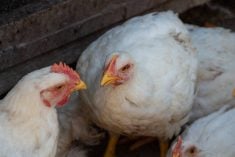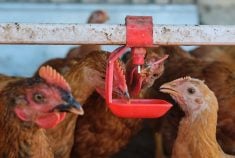Up against several outbreaks of highly pathogenic avian flu in commercial poultry flocks, Ontario is temporarily banning birds from appearing at shows and other such events.
Provincial Agriculture Minister Lisa Thompson on Friday announced a ministerial order taking effect just after midnight Saturday (April 9), in which “the movement to and participation of birds in events where they commingle, such as shows, sales, swaps, fairs, sport and educational displays is prohibited.”
Thompson’s order is in addition to Canadian Food Inspection Agency requirements on the movement of birds into, out of or through primary control zones (PCZs) set up around areas where outbreaks have occurred.
Read Also

U.S. livestock: ‘Cattle on feed’ report supports prices
Chicago cattle futures rose as the USDA’s ‘Cattle on Feed’ report showed inventories two per cent down from a year…
The order expires May 9 “but may be extended if required,” the province said.
The purpose of the order, the province said, is “limiting the commingling of birds from different locations in order to reduce the risk of disease transmission.”
In Ontario, CFIA has so far confirmed high-path avian flu at seven poultry farms and in three backyard flocks since March 27.
The agency has also confirmed high-path avian flu of an “H5 subtype” in wild birds at two separate spots in the province. In one outbreak, reported March 10 in the Wilmot area just west of Kitchener, the disease was found in a red-breasted merganser and a red-tailed hawk. In the other, reported March 15, a redhead duck and a Canada goose were found infected in the Ottawa area.
Where most of the commercial and backyard bird outbreaks in Ontario in this run of avian flu were found to be of the H5N1 strain seen in recent months in Europe and later in the Maritimes and several U.S. states, the wild birds in Ontario were carrying an H5 subtype with “re-assortments of Eurasian and North American lineage,” CFIA said in a report to the World Organization for Animal Health (OIE).
First finding
On top of the outbreaks in commercial birds in Ontario, Nova Scotia and most recently Alberta, high-path avian flu has also been reported in recent months in wild and/or non-commercial birds in all four Atlantic provinces, Quebec, Ontario, British Columbia — and, as of Friday, Saskatchewan.
The Saskatchewan ag ministry on Friday announced that samples collected from a wild snow goose found near Elrose, Sask., about 115 km north of Swift Current, had been confirmed positive by CFIA as having a high-path H5 strain of avian flu.
The snow goose marks the first finding of high-path avian flu in either commercial or wild birds in Saskatchewan since 2007, when commercial birds on a poultry farm near Regina Beach, Sask. contracted an H7N3 strain.
The Alberta and Saskatchewan cases coincide with the return of migratory birds to the region, many on migratory flyways through areas of the U.S. that have recently had outbreaks of high-path H5N1.
As of Friday, the U.S. Department of Agriculture’s Animal and Plant Health Inspection Service (APHIS) had confirmed high-path avian flu in 25 states, of which five directly border onto Canada.
APHIS since February has reported cases in commercial and/or backyard flocks in Connecticut, Delaware, Illinois, Indiana, Iowa, Kansas, Kentucky, Maine, Maryland, Massachusetts, Michigan, Minnesota, Missouri, Nebraska, New Hampshire, New York, North Carolina, North Dakota, Ohio, South Dakota, Texas, Virgina, Wisconsin, Wyoming — and, as of Friday, Montana.
APHIS said Friday it had confirmed high-path bird flu in two “non-commercial” backyard flocks in Montana — one in Cascade County around Great Falls, about 190 km south of the Alberta border, and the other in Judith Basin County, just east of Cascade County.
Saskatchewan’s ag ministry said Friday that protecting commercial flocks should include measures such as keeping wild birds away from poultry flocks and their food and water supplies, limiting visitors and monitoring bird health.
Small or backyard flocks are considered particularly high-risk for high-path avian flu infection as they are most often raised in an “extensive fashion” — that is, allowed access to outdoor pens or free-range, which means a “high probability” of contact with wild birds or contaminated environments.
The province said it would encourage small-flock owners to confine birds indoors if at all possible “during this high risk period of wild bird migration,” and to follow the same measures as commercial flocks. –– Glacier FarmMedia Network















